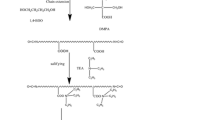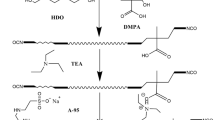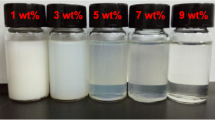Abstract
Waterborne polyurethane (WPU) with different macromolecular diols as soft segments was synthesized by the acetone dilution method. Fourier transform infrared (FTIR) spectroscopy, particle size and distribution (PSD) and transmission electron microscopy (TEM) test measurements were utilized to characterize the structure. The effect of the structure on performance was determined by the solids content, rheological and thixotropic behavior tests, water absorption tests and adhesion tests. It was found that with different macromolecular diols as a soft segment polyurethane has low water absorption, high energy storage, good shear resistance and adhesion. The minimum water absorption value was 6.02%.










Similar content being viewed by others
References
Doyle EN (1971) The development and use of polyurethane products. McGraw-Hill
Wang H, Zhou Y, He M, Dai Z (2015) Effects of soft segments on the waterproof of anionic waterborne polyurethane. Colloid Polym Sci 293:875–881
Lu Y, Larock RC (2007). Biomacromolecules. 8:3109
Gurunathan T, Mohanty S, Nayak SK (2014). J Mater Sci 49:8017
Chang WH, Scriven RL, Peffer JR, Jr SP (1973). Ind Eng Chem Prod Res Develop 12:282
Wang H, Niu Y, Fei G, Shen Y, Lan J (2016) In-situ polymerization, rheology, morphology and properties of stable alkoxysilane-functionalized poly (urethane-acrylate) microemulsion[J]. Progress in Organic Coatings 99:400–411
Li Q, Guo L, Qiu T, Xiao W, du D, Li X (2016) Synthesis of waterborne polyurethane containing alkoxysilane side groups and the properties of the hybrid coating films[J]. Appl Surf Sci 377:66–74
Guyot A, Landfester K, Schork FJ et al (2007) Hybrid polymer latexes[J]. Prog Polym Sci 32(12):1439–1461
Hirose M, Zhou J, Nagai K (2000) The structure and properties of acrylic-polyurethane hybrid emulsions[J]. Progress in Organic Coatings 38(1):27–34
Patil CK, Rajput SD, Marathe RJ, Kulkarni RD, Phadnis H, Sohn D, Mahulikar PP, Gite VV (2017) Synthesis of bio-based polyurethane coatings from vegetable oil and dicarboxylic acids[J]. Progress in Organic Coatings 106:87–95
Zhang SF, Wang RM, He YF, Song PF, Wu ZM (2013) Waterborne polyurethane-acrylic copolymers crosslinked core–shell nanoparticles for humidity-sensitive coatings[J]. Progress in Organic Coatings 76(4):729–735
Lu Y, Hao J, Xiao G, Chen L, Wang T, Hu Z (2017) Preparation and properties of in situ amino-functionalized graphene oxide/polyimide composite films[J]. Appl Surf Sci 422:710–719
Wang L, Zhu Y, Qu J (2017) Preparation and assistant-film-forming performance of aqueous polyurethane dispersions[J]. Progress in Organic Coatings 105:9–17
Yen MS, Kuo SC (1998) Effects of a soft segment component on the physical properties of synthesized waterborne polyurethanes by using triblock ester-ether copolydiol as the soft segment. J Polym Res 5:125–131. https://doi.org/10.1007/s10965-006-0048-5
Wang Y, Lue A, Zhang L (2009) Rheological behavior of waterborne polyurethane/starch aqueous dispersions during cure[J]. Polymer 50(23):5474–5481
Peng SJ, Jin Y, Cheng XF, Sun TB, Qi R, Fan BZ (2015) A new method to synthesize high solid content waterborne polyurethanes by strict control of bimodal particle size distribution[J]. Progress in Organic Coatings 86:1–10
Yuan C, Wang J, Cui M et al (2016) Aqueous PUA emulsion prepared by dispersing polyurethane prepolymer in polyacrylate emulsion[J]. Journal of Applied Polymer Science 133(11) n/a-n/a.17
Koscielecka A (2010) Thermal stability of polyurethanes with allophanate and isocyanurate crosslinks[J]. Acta Polymerica 42(5):221–225
Zhang J, Li X, Shi X, Hua M, Zhou X, Wang X (2012) Synthesis of core-shell acrylic-polyurethane hybrid latex as binder of aqueous pigment inks for digital inkjet printing[J]. Progress in Natural Science:Materials International 22(1):71–78
Wang C, Chu F, Guyot A (2006) Mechanical properties of films from hybrid acrylic-polyurethane polymer colloids[J]. Journal of Dispersion Science & Technology 27(3):325–330
Qiu FX, Zhang JL, Wu DM et al (2013) Waterborne polyurethane and modified polyurethane acrylate composites[J]. Plastics Rubber & Composites 39(10):454–459
Sheng Y, Jiang P, Zhang D, Hua J (2015) Synthesis and characterization of sustainable polyurethane modified by cyclic polysiloxane[J]. J Appl Polym Sci 132(2)
Teramoto N, Saitoh Y, Takahashi A, Shibata M (2010) Biodegradable polyurethane elastomers prepared from isocyanate-terminated poly(ethylene adipate), castor oil, and glycerol[J]. J Appl Polym Sci 115(6):3199–3204
Jinwei H, Duoxian S, Zhenyu Y (2003) Study on particle size and viscosity properties of waterborne polyurethane[J]. Journal of Tianjin University: Natural Science and Engineering Technology 36(6):719–723
Acknowledgements
This work is supported by the National Key R&D Program of China (2017YFB0308700), The National Natural Science Foundation of China (21676003), Beijing Municipal Science and Technology Project (D17110500190000).
Author information
Authors and Affiliations
Corresponding author
Additional information
Publisher’s note
Springer Nature remains neutral with regard to jurisdictional claims in published maps and institutional affiliations.
Rights and permissions
About this article
Cite this article
Song, N., Xin, X., Liu, H. et al. Effects of different macrodiols as soft segments on properties of waterborne polyurethane. J Polym Res 26, 152 (2019). https://doi.org/10.1007/s10965-019-1793-6
Received:
Accepted:
Published:
DOI: https://doi.org/10.1007/s10965-019-1793-6




